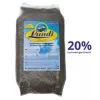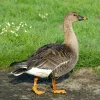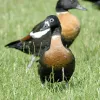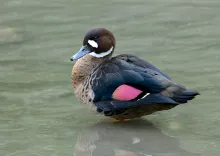
Bronze-winged duck (Speculanas specularis)
Species name
- Dutch name:
- Bronsvleugeleend
- English name:
- Bronze-winged duck
- German name:
- Kupferspiegelente
- French name:
- Canard à lunettes
- Scientific name:
- Speculanas specularis
Scientific classification
- Order:
- Anseriformes
- Family:
- Anatidae
- Onderfamilie:
- Anatinae
- Genus:
- Speculanas
Description
- Description:
Male:
Head and upper neck Chocolate brown, with clear white oval patch in front of eye, and second white patch on chin and throat extending up sides of neck to broad point below ears. Lower neck, breast, flanks and belly fawn-brown, lightly mottled darker brown on breast and belly, but with heavier uneven scallop marks on flanks, contrasting with pale feather edgings; centre of belly, vent and under tail converts unmarked fawn-brown. Mantle and scapulars dark brown to blackish, with paler feather edgings, and with slight green-purplish sheen, this more apparent on completely dark tertails; back, rump, upper tail- converts and tail dark brown. Conspicuous brilliant bronze iridescent speculum, variously shot with pinkish purple, bordered to rear with black and white bands, while rest of upper wing, both coverts and primaries very dark brown with purplish sheen; under wing dark, except for grey axillaries. Bill blue-grey, with black on culmen and black nail. Legs and feet yellowish orange, with brownish webs.Female:
Slightly smaller then male almost identical, but duller, having less sheen on upper parts and upper wings.Juvenile:
Much duller then the adults, with facial pattern reduced or even absent, and breast and under-parts heavily streaked.
Standard Measurements
- Body Length (cm):
- The male (drake) of the Bronze-winged duck measures approximately 46-54 centimeters. The female measures approximately 46-54 centimeters.
- Body Weight (grams):
- The male will weight about 1130-1460 gram. The female will weight about 900-1070 gram.
The weight is notoriously variable and can only be used as indication!
- Note:
The nest is built on the ground and is often found on small islets in the water. The nest well is densely covered with down. The female alone breeds. For Bronze-winged ducks kept in aviculture, the breeding season is 30 days. The male is involved in the leadership of the chicks.
- Breeding:
- The female Bronze-winged duck usually lays from 4-6 cream to pale coffee eggs and incubates them for 30 days.
- Artificial incubating:
The ideal relative humidity for incubating most waterfowl eggs is 55% (ground nesters) and 40% (cavity nesters). The temperature is usually 37.4°C. Set ventilation as recommended by the incubator manufacturer. Eggs must be turned, either automatically or by hand, a minimum of 4 times a day. As the duckling develops there is a loss of water from the egg and the air sac gets bigger. In normal development of an egg with a 30 days incubation, the air sac occupies about a third of it three days earlier. Cleanliness is vital and ideally eggs should be moved to a separate hatcher at this point, where the humidity should be increased to 65% and even higher once they have pipped internally.
- Bird banding:
- Recommended closed leg band ring size for the Bronze-winged duck is 12 mm.The leg band ring can only be applied on a young dabbling duck at around 12-14 days old.
- It doesn't matter what leg that you band, but it's good to have a consistent system. Suggested: Left leg = Female, Right leg = Male
- Rearingfeed:
-



Floatable special rearing feed for all types of aquatic ornamental fowl - especially for the cultivation of trees as well as greening ducks.
This well-balanced complete feed with 20% protein content convinces above all by its good compatibility and forms the basis for visibly healthy growth from day one.
Made exclusively from wholesome and selected raw materials, Lundi Micro Regular is also ideally suited for the year-round feeding of waterfowl.
- Maintenance food:
-





Floating full food for all sea ducks, green ducks, eider ducks and geese, especially in the moulting and breeding phase ideally suited. Packed with wholesome raw materials, natural vitamins and trace elements, this performance food with a protein content of 30% forms the basis for lifelong vitality.



